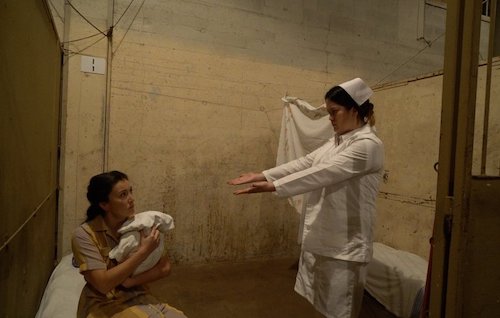 A new play about the internment of Japanese-Canadians during WWII is presented in Toronto
A new play about the internment of Japanese-Canadians during WWII is presented in Toronto
Canadians are often guilty of a kind of smug, exceptionalism when it comes to issues of diversity and inclusion, especially when we compare ourselves to the giant dumpster fire that is the US. Rarely do we acknowledge or critically examine our own dark history.
Events like our government’s forced internment of thousands of Canadians of Japanese heritage during World War II remain untaught or under-taught in our high school history classes. That’s why works like Japanese Problem are so vital if we are to truly understand who we are as a country.
In 1942, the Canadian government forcefully detained over 8,000 Canadians of Japanese heritage and housed them in the barns at Vancouver’s Hastings Park on the grounds of the Pacific National Exhibition; also confiscating their property and separating families in the process.
A Vancouver-based collective of artists known as Universal Limited, led by Yoshié Bancroft and Joanna Garfinkel, set out to tell this unacknowledged story. The resulting play, Japanese Problem, is a site-specific work that the company debuted at Hastings Park in 2017.
For this run in Toronto, this site-specific piece is obviously no longer being performed in its specific site but rather it has been transferred to a collection of studio spaces at the Young Centre for the Performing Arts. While it loses the immediacy and sense of place that comes with performing in the actual space where the events occurred, the story remains resonant and powerful.
The piece clocks in at an economical 45 minutes. Each actor addresses the audience directly to introduce their character: Sam and Kenji (Yoshié Bancroft and Brent Hirose), two detainees; Johnny (Daniel Deorksen), a guard; and Maggie (Nicole Yukiko), a nurse who is also a detainee.
They lead the audience through a set re-creating the stalls which housed the detainees in the barn at Hastings Park and in a few short vignettes we get just enough of a sense of each character’s backstory as well as a vivid illustration of what life was like in detention.
Not a lot of time is spent on character or plot development but I don’t think these individuals are intended to be fully fleshed-out fictional characters per se but rather, they are archetypes. I was immediately drawn to the characters and experienced a deep sense of empathy for them precisely because I knew they were composites representing real people who experienced these events.
I enjoyed the decidedly low-tech aesthetic of the show—including a shadow-puppet play using an overhead projector and some bed sheets—which adds to the charm and authenticity of the piece as these are the same theatrical storytelling devices people of that era would have had access to.
I was also a bit taken aback by the show’s somewhat meta approach; the actors acknowledge that this is a historical re-enactment at the top and at times during the show they would abruptly break character to make some sort of self-aware comment.
While I found it a bit jarring at first, I ultimately think that having actors break the fourth wall is an effective device. It acknowledges that this isn’t just some history pageant and the events depicted do not exist in some isolated past, reparations can never fully make up for what happened nor can they erase the inter-generational trauma experienced by the detainees and their families.
While the ending of the show takes a bit of an unconventional, meta approach, I nonetheless found it moving. As did several other audience members whom I saw wiping away tears after the curtain call. Luckily, the audience is invited to a talk-back after the play, which provides a valuable opportunity for emotional catharsis, reflection and sharing.
Japanese Problem is an invitation to a conversation and a reflection that we ought to be having as a country. The underlying systemic racism that led to the depicted events has never been addressed, Japanese Problem is also very much a cautionary tale for today.
While advance tickets are sold out, it’s very much worth showing up early for one of the few rush tickets available for each performance. I’d also love to see a future iteration of the show brought back for a longer run.
Details:
- Japanese Problem is playing through October 28, 2018 at the Young Centre for the Arts, 50 Tank House Lane, in the Distillery Historic District, Toronto.
- Tickets are $25
- Advance tickets are sold out to early subscribers however a limited number (8-10) of P.W.Y.C.A. (Pay What You Can Afford) Rush Tickets are available for all performances at the Box Office, and go on sale 60 minutes prior to show time. In person only, limit of 2 tickets per person.
Photo of Yoshie Bancroft and Nicole Yukiko by Mona Stilwell / Bob Baker
